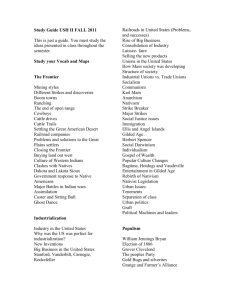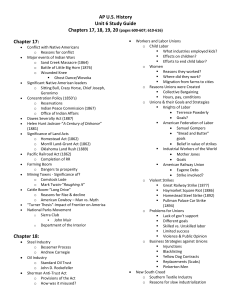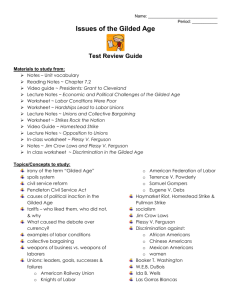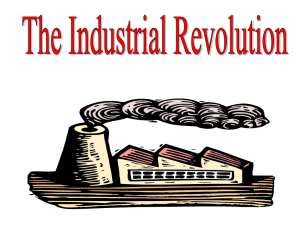Child Labor
advertisement
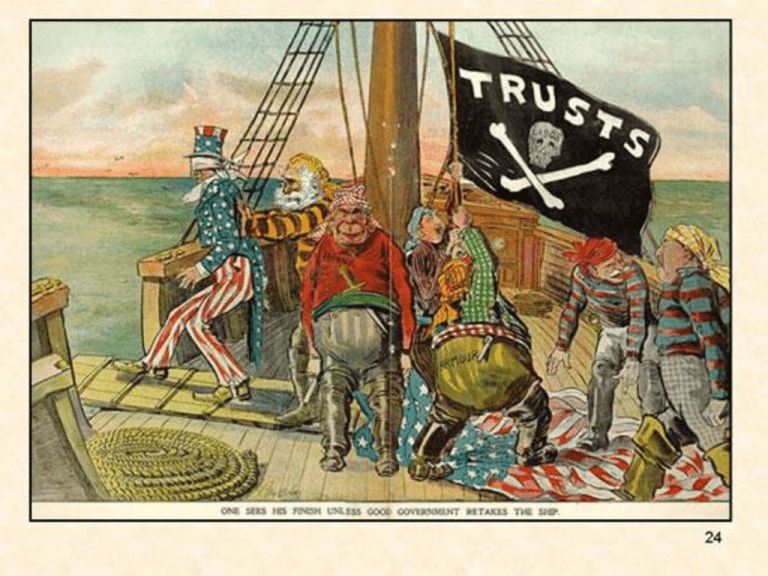
Labor in the Gilded Age Women and Children Industry’s Main Goal • Industry’s main goal is to maximize production. • Machines were more profitable than workers during the Gilded Age. • Workers must engage in class politics to combat the actions of business leaders and management. Gilded Age Labor Quick Facts • Unskilled Labor • Use of the contract system • Unskilled workers often moved city to city, factory to factory looking for work • Worked up to 12 hour shifts • Inexperience, factory conditions, and fastpaced production led to frequent accidents • In 1880 most working women were between 18 and 26 and unmarried. Women in the Industrial Age • Upper-class women believed in, and lived in, “separate spheres.” • Women remained at home, raised the children, and performed housework. Men were the breadwinners and held the public sphere of the family. • Married working-class women often worked in sweatshops or from home finishing tasks (particularly in the clothing industry) • Single working women often viewed factory work as a way to avoid domestic work. • Factory jobs paid better than domestic jobs. • Creation of office jobs Child Labor: the Lucky Ones • Child labor was a national disgrace during the Gilded Age. The lucky ones swept the trash and filth from city streets or stood for hours on street corners hawking newspapers. Child Labor: the Less Fortunate • The less fortunate coughed constantly through 10-hour shifts in dark, damp coal mines or sweated to the point of dehydration while tending fiery glassfactory furnaces. Children in the Textile Industry Child Labor Quick Facts • In coal mines and cotton mills, children entered the work force as early as 8 or 9. • Used in tight spaces • Coal industry placed them below the chute which broke coal to remove any impurities • Prone to being injured by pulleys A Matter of Survival • By and large, these child laborers were the sons and daughters of poor parents or recent immigrants who depended on their children's meager wages to survive. 1870: 750,000 Child Laborers • In 1870, the first U.S. census to report child labor numbers counted 750,000 workers under the age of 15, not including children who worked for their families in businesses or on farms. 1911: 2 Million Child Laborers • By 1911, more than two million American children under the age of 16 were working - many of them 12 hours or more, six days a week. Often they toiled in unhealthful and hazardous conditions; always for minuscule wages. Photographer Lewis W. Hine • But until the documentary photographs of Lewis Wikes Hine appeared in popular and progressive publications in the early 1900s the public turned a blind eye to the pervasive and cruel exploitation of children in the work place. Gilded Age Labor Politics Key Terms • Closed shop: employees of the company are only union members • Union shop: employees are hired without being a member, but must become a member within a specified time • Open shop: does not restrict employees to union members Key Points on American Labor History 1. 2. 3. 4. Limited Radicalism (exception: IWW) Workers live at the economic margins Practicality Dependent on a worker culture Paul Douglas’ Model of Labor Workers have four different levels of attainment: 1. Poverty: inadequate diet, unhealthy conditions, no resources for unexpected events 2. Minimum Subsistence: meet basic needs, but have no additional funds 3. Minimum Health & Decency: adequate funds for needs; small amount left over for leisure 4. Minimum Comfort: funds for comforts (leisure and savings) Douglas argues that American workers never make it to minimum comfort. Why don’t they do anything? Labor Unions • Why does management dislike unions? • Union workers typically receive higher pay • Union workers typically receive higher benefits • Union workers have more leverage over management (strength in numbers) Labor Unions, Management, and Government • Management usually has the government on their side. • Strikes are often broken when the government steps in • Government and management and more aligned because: • They both want economic growth. • They both want order (less conflict). • 1902 is the first time in American History that the federal government favors workers (TR does not break the United Mine Workers Strike). Where are labor unions successful? • Labor unions are more successful in big cities and immigrant towns. • Labor unions work like an interest group or a political machine. • Transactional politics • Unions back parties and candidates that are sympathetic to their issues.
